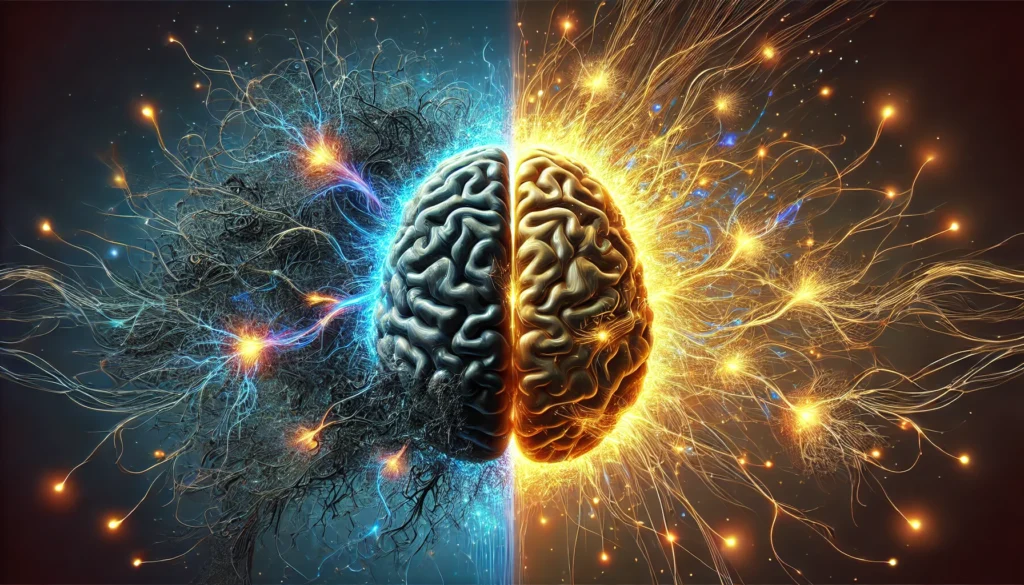The Science Behind Habit Formation and Memory Strengthening
Our brains are remarkable organs, capable of adapting, learning, and evolving throughout our lifetimes. One of the most fascinating aspects of brain function is neuroplasticity, the ability of neural pathways to change in response to experiences, habits, and learning. This process is central to both breaking old habits and building new ones, a transformation that research suggests takes approximately 21 days. Understanding why it takes 21 days to break a habit provides insights into strengthening neural pathways, ultimately enhancing memory and recall.
You may also like: Habit Formation and Neural Pathway Strengthening: Unlocking the Psychology of Lasting Memory & Recall
The brain operates through intricate networks of neurons that communicate via synaptic connections. When we engage in repetitive behaviors, these connections become stronger, forming deeply ingrained habits. Similarly, when we actively work to alter these behaviors, our neural networks adjust, allowing for the formation of new habits and improved cognitive functions. The 21-day rule is rooted in research suggesting that this timeframe represents the minimum period necessary for neuroplastic changes to take hold, making it a crucial window for those seeking to enhance their memory and cognitive resilience.
The 21-Day Habit Rule: Fact or Myth?
The idea that it takes 21 days to break a habit has been widely accepted, but its origins trace back to the 1950s when Dr. Maxwell Maltz, a plastic surgeon, observed that his patients took approximately three weeks to adjust to changes in their appearance. This observation was later generalized to habit formation. However, modern research suggests that the time required to break a habit or establish a new one varies based on individual differences, the complexity of the habit, and the consistency of behavior change.
Neuroscientific studies indicate that breaking a habit involves rewiring neural pathways, a process that depends on factors such as emotional investment, motivation, and repetition. While 21 days may be sufficient for minor changes, more deeply ingrained habits may require longer periods. Nonetheless, this three-week benchmark serves as a useful guideline for those aiming to strengthen their neural pathways and optimize memory function through deliberate and sustained efforts.
How Neural Pathways Strengthen Through Habit Formation
Neural pathways are reinforced through repeated activation, a principle known as Hebbian learning: “neurons that fire together, wire together.” When a new habit is formed, neural circuits are gradually rewired, making the behavior more automatic. This process is crucial not only for habit formation but also for memory strengthening.
Memory consolidation occurs when experiences and information are transferred from short-term to long-term memory. This transfer is facilitated by strong neural connections, which are enhanced through repetition, association, and reinforcement. Engaging in memory-boosting activities such as learning new skills, practicing mindfulness, or engaging in regular cognitive exercises can significantly improve the efficiency of these neural pathways, leading to better recall and cognitive longevity.
Strategies to Break Unwanted Habits and Strengthen Memory
Breaking an unwanted habit requires conscious effort, persistence, and a structured approach. The same principles apply to strengthening memory, as both processes involve the deliberate reshaping of neural connections. Several strategies can facilitate this transformation:
- Identify Triggers and Replace Negative Patterns – Understanding what prompts an undesirable habit is the first step toward breaking it. Whether it’s stress, boredom, or social influences, recognizing these triggers allows for the implementation of healthier alternatives, thereby reinforcing positive neural pathways.
- Practice Repetition and Consistency – Since it takes 21 days to break a habit, consistency is key. Engaging in new, beneficial behaviors daily strengthens neural pathways, making the new habit more ingrained and reducing the likelihood of reverting to old patterns.
- Incorporate Cognitive Exercises – Memory-boosting activities such as puzzles, learning new languages, or practicing recall techniques improve neural plasticity, enhancing cognitive function and retention.
- Engage in Physical Activity – Exercise promotes neurogenesis (the growth of new neurons) and improves blood flow to the brain, supporting overall cognitive health and memory enhancement.
- Utilize Mindfulness and Meditation – Stress and anxiety can impair memory and make breaking habits more difficult. Mindfulness practices reduce cortisol levels and promote a focused state of mind, facilitating better learning and habit transformation.
- Ensure Quality Sleep and Nutrition – Sleep plays a crucial role in memory consolidation and cognitive performance. A well-balanced diet rich in omega-3 fatty acids, antioxidants, and essential vitamins supports brain function and neural connectivity.

The Connection Between Memory Enhancement and Habit Formation
The interplay between memory enhancement and habit formation is deeply rooted in neurobiology. Forming new habits strengthens cognitive function by fostering neuroplasticity, while improved memory retention aids in the successful establishment of positive behavioral patterns. Studies suggest that individuals who actively engage in learning new habits also experience improved memory recall due to the increased neural activity associated with these efforts.
Furthermore, memory techniques such as the method of loci, spaced repetition, and mnemonic devices have been shown to enhance recall by reinforcing synaptic connections. When these techniques are integrated into daily routines, they contribute to both stronger memory retention and the successful reinforcement of new, positive habits.
The Role of Environment in Habit and Memory Formation
The environment plays a crucial role in both habit formation and memory enhancement. External stimuli, including social influences, physical surroundings, and habitual cues, can either reinforce positive behaviors or perpetuate negative ones. By strategically modifying one’s environment—such as reducing distractions, structuring routines, and incorporating cognitive challenges—individuals can create optimal conditions for both habit transformation and improved memory function.
One effective approach is the deliberate use of environmental cues to trigger desirable behaviors. For example, placing a book in a visible location may serve as a reminder to engage in daily reading, thereby reinforcing both the habit of learning and the strengthening of memory. Likewise, reducing exposure to distractions and establishing structured schedules fosters consistency, enabling neural pathways to reinforce beneficial behaviors.
The Influence of Emotional and Psychological Factors on Habit Formation
Emotions and psychological states significantly impact the ability to break habits and enhance memory. Stress, anxiety, and emotional triggers often reinforce negative habits, making them harder to break. Conversely, positive emotional reinforcement strengthens the neural pathways associated with beneficial behaviors, making them more sustainable in the long run.
Practicing emotional regulation techniques such as deep breathing, visualization, and cognitive reframing can help individuals manage stress and improve their ability to form new habits. Additionally, fostering a positive mindset and celebrating small victories along the journey enhances motivation and increases the likelihood of long-term habit retention.
Frequently Asked Questions (FAQ)
1. Why does it take 21 days to break a habit?
The idea that it takes 21 days to break a habit comes from observations about how our brains adapt to new behaviors. However, the exact timeframe can vary based on the complexity of the habit, individual differences, and the level of commitment to change. Breaking a habit requires weakening existing neural pathways while simultaneously strengthening new ones, which can be challenging if a habit is deeply ingrained. Psychological factors, such as emotional attachment or external stressors, can either accelerate or hinder the process. While 21 days to break a habit serves as a useful guideline, individuals may require more time to fully rewire their behavior.
2. What psychological techniques can help break a habit faster?
Psychologists recommend techniques such as cognitive reframing, implementation intentions, and self-monitoring to speed up the habit-breaking process. Cognitive reframing involves changing the way you perceive a habit, reducing its perceived reward and replacing it with a more beneficial alternative. Implementation intentions, or “if-then” planning, prepare your brain to respond to triggers with healthier behaviors. Self-monitoring through journaling or habit-tracking apps increases self-awareness, reinforcing commitment to change. Although it takes 21 days to break a habit for some, those who actively apply these psychological strategies may see faster results.
3. How do financial habits impact cognitive function and memory?
Financial habits shape long-term cognitive function by influencing stress levels, decision-making skills, and overall mental clarity. Poor financial management can increase anxiety, leading to cognitive overload that disrupts memory retention and learning. Conversely, well-structured financial habits, such as automated savings and mindful spending, reduce decision fatigue and free mental energy for higher-order thinking. Studies suggest that those who practice financial discipline engage in more effective long-term planning, reinforcing neural pathways associated with strategic thinking. While 21 days to break a habit applies to many behavioral changes, financial habits often require additional reinforcement due to their long-term implications.
4. Can breaking a habit improve long-term memory?
Yes, breaking a habit can enhance long-term memory by reducing cognitive load and allowing the brain to allocate resources more efficiently. When bad habits are eliminated, particularly those that involve multitasking or passive consumption of information, cognitive capacity increases. This means the brain has more space to process, store, and recall essential information. Additionally, forming new, memory-boosting habits—such as engaging in mental exercises or maintaining a structured daily routine—further strengthens neural pathways. Although it takes 21 days to break a habit, sustained effort beyond this period can lead to significant memory improvements.

5. What role does social influence play in breaking a habit?
Social influences significantly impact habit formation and dissolution, as individuals tend to mirror the behaviors of those around them. Engaging with supportive peer groups or accountability partners increases motivation and consistency in adopting new habits. Studies show that people who join group-based interventions, such as fitness programs or financial accountability groups, are more likely to sustain positive behavioral changes. Conversely, remaining in environments that reinforce old habits can make breaking them more difficult. Understanding that it takes 21 days to break a habit is helpful, but surrounding oneself with the right influences often determines long-term success.
6. How does stress impact habit formation and memory?
Chronic stress disrupts the brain’s ability to form new habits and recall information by impairing neural plasticity. When stress hormones such as cortisol are elevated, the prefrontal cortex—responsible for rational decision-making—becomes less effective. This makes it harder to replace unwanted habits with positive alternatives. Additionally, stress weakens memory consolidation, leading to forgetfulness and cognitive fatigue. Managing stress through mindfulness, exercise, and relaxation techniques enhances both habit-breaking efforts and memory retention, reinforcing the notion that while 21 days to break a habit is a guideline, stress management is key to long-term success.
7. What is the connection between sleep and habit change?
Sleep plays a crucial role in habit transformation by strengthening new neural connections and facilitating memory consolidation. During deep sleep, the brain processes and integrates new behaviors, reinforcing the pathways necessary for habit change. Lack of sleep impairs impulse control, making it more difficult to resist reverting to old habits. Studies indicate that individuals who maintain consistent sleep schedules are more successful in replacing bad habits with positive ones. While it takes 21 days to break a habit, poor sleep habits can significantly delay progress, underscoring the importance of restorative rest.
8. How can mindfulness accelerate habit-breaking and memory improvement?
Mindfulness enhances self-awareness, allowing individuals to recognize habit triggers and consciously choose alternative behaviors. By practicing mindfulness, one can observe thoughts and impulses without automatically acting on them, thereby weakening the reinforcement of unwanted habits. Additionally, mindfulness improves memory by reducing stress, increasing focus, and fostering deeper engagement with learning activities. Integrating mindfulness into daily routines can create long-term cognitive benefits, making it easier to develop sustainable habits. Given that it takes 21 days to break a habit, mindfulness serves as a valuable tool to maintain consistency and reinforce neural changes.
9. Are there specific foods that support habit formation and cognitive function?
Yes, diet plays a crucial role in both breaking habits and strengthening memory by providing the brain with essential nutrients. Omega-3 fatty acids, found in fish and flaxseeds, support neural connectivity and cognitive flexibility, aiding in habit change. Antioxidant-rich foods such as berries and dark chocolate reduce inflammation and improve focus, making it easier to stay committed to new behaviors. Additionally, foods high in B vitamins, like whole grains and leafy greens, enhance neurotransmitter function, promoting better decision-making and emotional regulation. Since it takes 21 days to break a habit, a well-balanced diet can accelerate cognitive adaptation and improve overall mental resilience.
10. How can technology aid in habit transformation and memory enhancement?
Technology offers various tools to assist in habit-breaking and memory improvement, from habit-tracking apps to cognitive training platforms. Digital reminders and gamified habit-forming apps help reinforce consistency, ensuring new behaviors become ingrained. Wearable technology, such as smartwatches, can provide biofeedback on stress levels, sleep quality, and focus, allowing users to make data-driven adjustments. Additionally, online educational platforms offer interactive exercises designed to enhance memory retention and mental agility. While it takes 21 days to break a habit, leveraging technology effectively can optimize the process and create long-lasting behavioral change.
By addressing these frequently asked questions, readers can gain a deeper understanding of habit formation, memory enhancement, and the many factors influencing cognitive resilience. These insights offer fresh perspectives beyond the main article, empowering individuals to take a comprehensive approach to breaking habits and strengthening neural pathways.

Conclusion: The Path to Cognitive Mastery
The journey to strengthening neural pathways and optimizing memory function is an ongoing process that requires dedication, strategic approaches, and an understanding of how habits shape cognitive performance. While it takes 21 days to break a habit, the long-term benefits of this effort extend far beyond mere behavior modification. By leveraging neuroscience-backed strategies, individuals can enhance their memory, improve focus, and cultivate a resilient, adaptable mind.
Ultimately, cognitive mastery is within reach for those willing to invest in their mental well-being. By consistently engaging in practices that support neuroplasticity, individuals can not only break unwanted habits but also build a foundation for lifelong cognitive vitality. Whether the goal is to improve memory, increase productivity, or enhance overall brain health, the principles of habit formation and neural pathway strengthening provide a powerful framework for achieving lasting cognitive success.
Further Reading:
7 Principles of Neuroplasticity: Breaking Bad Habits & Boosting Your Brain
Important Note: The information contained in this article is for general informational purposes only, and should not be construed as health or medical advice, nor is it intended to diagnose, prevent, treat, or cure any disease or health condition. Before embarking on any diet, fitness regimen, or program of nutritional supplementation, it is advisable to consult your healthcare professional in order to determine its safety and probable efficacy in terms of your individual state of health.
Regarding Nutritional Supplements Or Other Non-Prescription Health Products: If any nutritional supplements or other non-prescription health products are mentioned in the foregoing article, any claims or statements made about them have not been evaluated by the U.S. Food and Drug Administration, and such nutritional supplements or other health products are not intended to diagnose, treat, cure, or prevent any disease.


